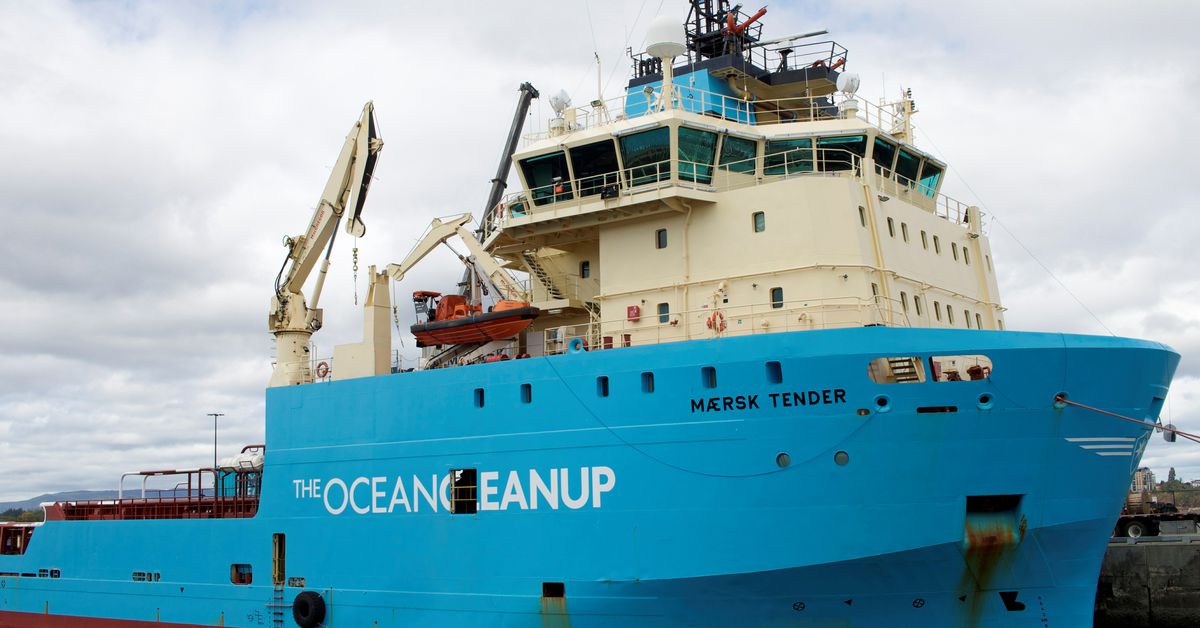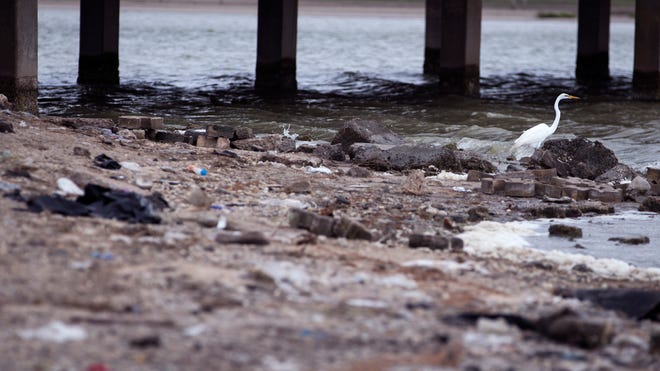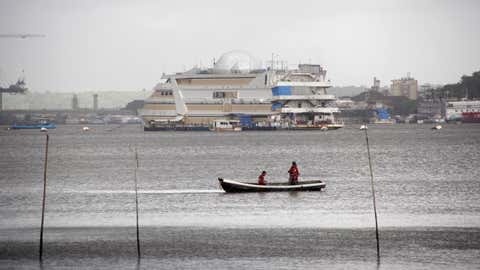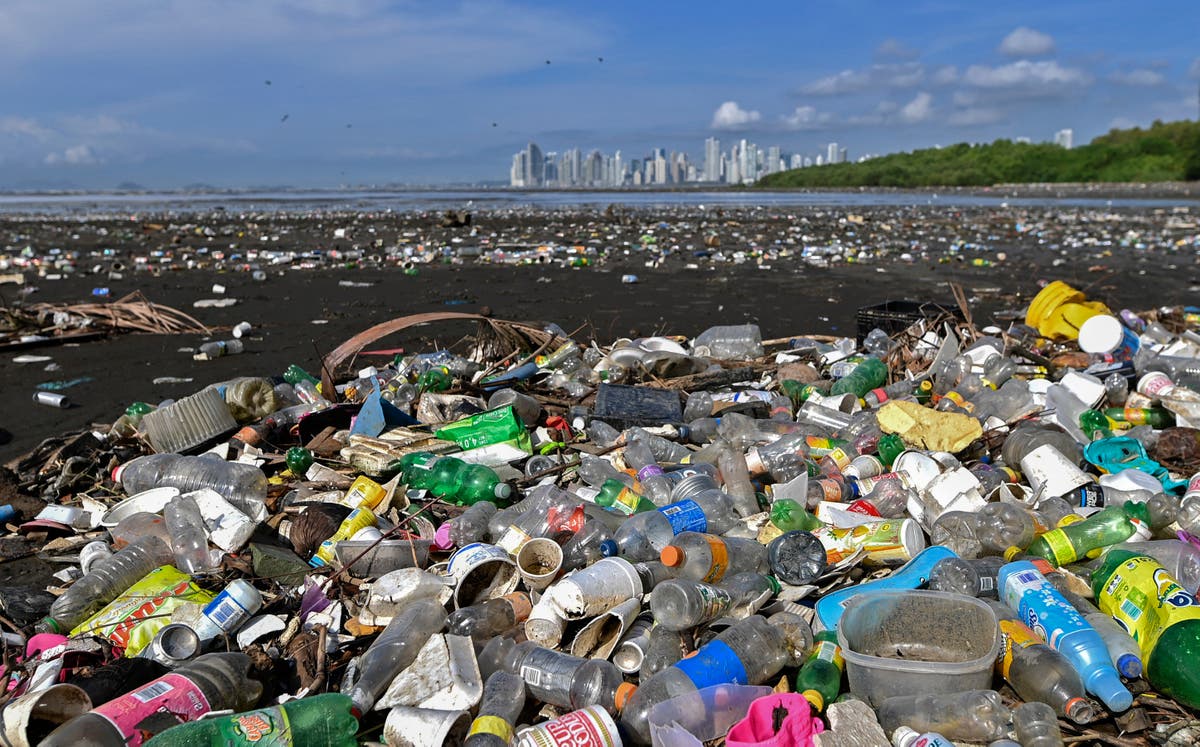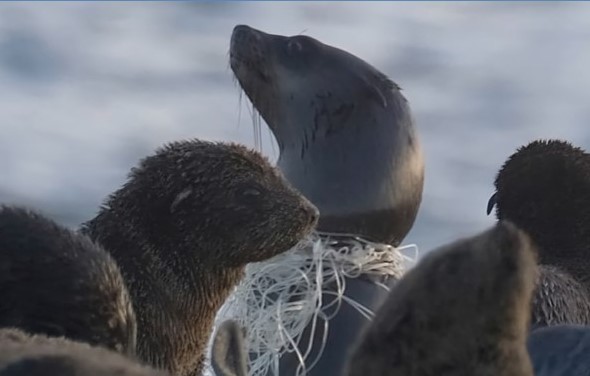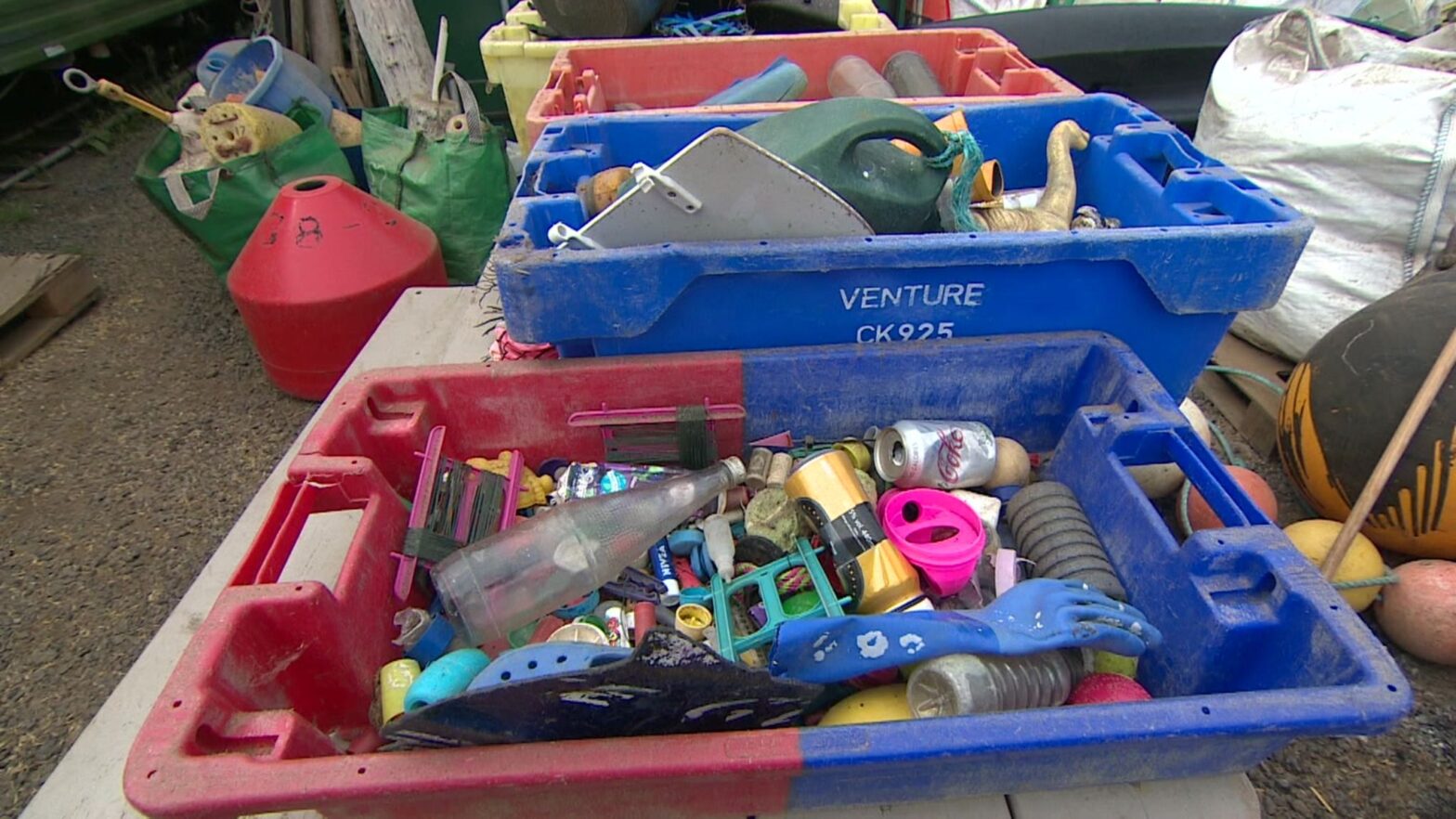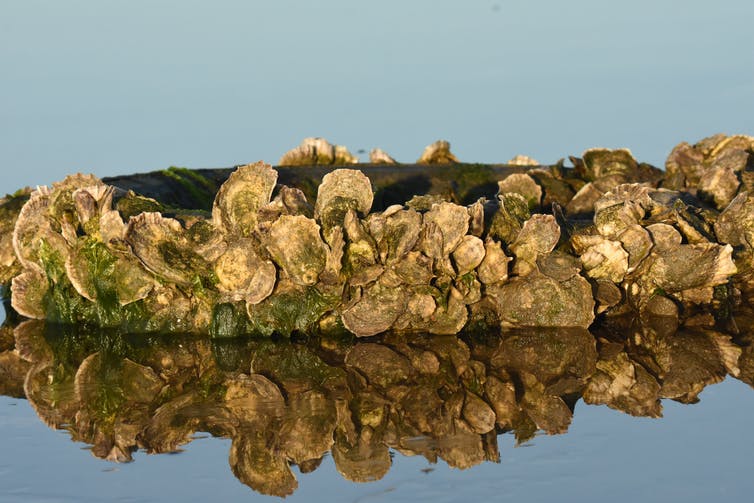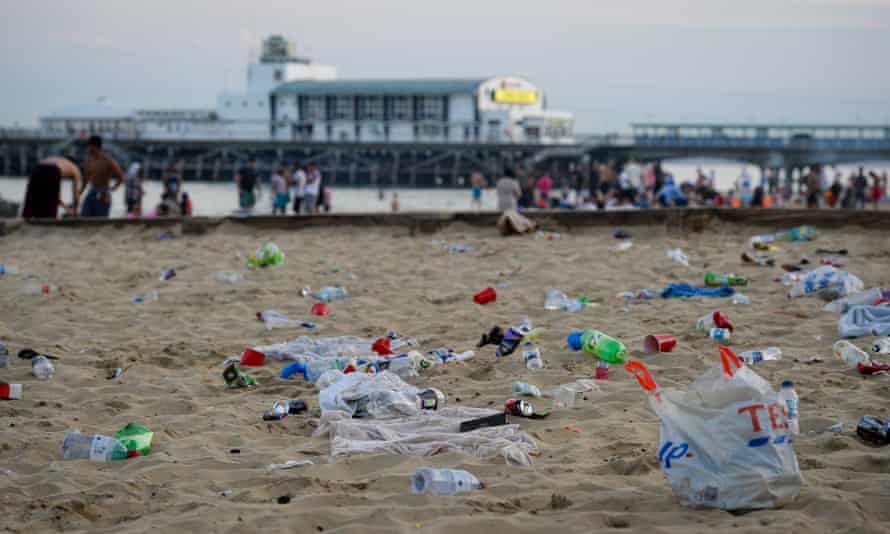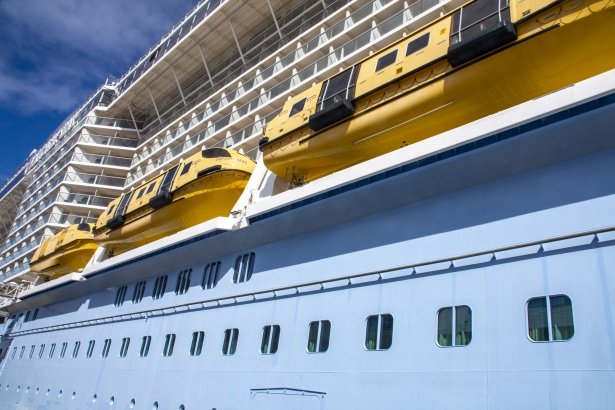VICTORIA, Canada, Sept 16 (Reuters) – Docked at a Canadian port, crew members returned from a test run of the Ocean Cleanup’s system to rid the Pacific of plastic trash were thrilled by the meager results — even as marine scientists and other ocean experts doubted the effort could succeed.The non-profit, launched in 2013 amid buoyant media coverage, hopes to clear 90% of floating plastic from the world’s oceans by 2040. But the group’s own best-case scenario — still likely years away — envisions removing 20,000 tonnes a year from the North Pacific, a small fraction of the roughly 11 million tonnes of plastic flowing annually into the oceans.And that amount entering the ocean is expected to nearly triple to 29 million tonnes annually by 2040, according to the Pew Charitable Trusts.The Ocean Cleanup, funded by cash donations and corporations including Coca-Cola (KO.N), as well as in-kind donors like A.P. Moller-Maersk (MAERSKb.CO), had fixed assets over $51 million (43 million euros) at the end of 2020.During 120 hours of deployment last month, System 002 — or “Jenny” as the crew nicknamed it — scooped up 8.2 tonnes of plastic, or less than a garbage truck’s standard haul. The Ocean Cleanup spokesperson Joost Dubois described the amount as “on the high end of our estimates” and emphasized that it was still just in the test phase.”I think they’re coming from a good place of wanting to help the ocean, but by far the best way to help the ocean is to prevent plastic from getting in the ocean in the first place,” said Miriam Goldstein, director of ocean policy at the Center for American Progress think tank.”Once plastic has gotten into the open ocean, it becomes very expensive and fossil-fuel intensive to get it back out again.”GARBAGE GYREThe Ocean Cleanup’s first target is the Great Pacific Garbage Patch, the world’s largest swirling mass of marine debris spanning 1.6 million square kilometers in the North Pacific between California and Hawaii. The group estimates the patch holds at least 79,000 tonnes of plastic.If the flow of plastic into the ocean continues unabated, the seas will contain more plastic mass than fish by 2050, according to the World Economic Forum.The Ocean Cleanup, created by Dutch inventor Boyan Slat when he was 18, initially planned on using an autonomous floating system driven by wind, waves and currents to remove plastic. But that first system, named Wilson, bobbed ineffectively alongside the garbage until it ultimately broke. A later design, System 001B, was more efficient, but the team estimated they would need 150 such systems to clear the patch at a high cost.With the Jenny system, two fuel-powered Maersk vessels tow the 520-meter wide horseshoe-shaped catchment system across the ocean surface. An underwater camera helps make sure marine life does not become entangled.”Jenny has outperformed everything we’ve done so far,” Dubois said of the recent six-week trials, during which the system picked up plastics small as 1 centimeter in diameter.The Ocean Cleanup hopes eventually to deploy 10 to 15 expanded-range Jennys — powered by 20 to 30 ships — to operate round the clock 365 days a year at the garbage patch. At that scale, organizers say, the effort could recover between 15,000 and 20,000 tonnes of plastic a year, though it would cost hundreds of millions of dollars.The group regrets its reliance on ships that release climate-warming greenhouse emissions. The Ocean Cleanup is purchasing carbon credits to offset the heavy fuel use and noted that Maersk is experimenting with less-polluting biofuels. “Preferably we would have done something without any carbon footprint,” Dubois said.Maersk told Reuters that, because of the patch’s harsh and remote location, large vessels were needed to assist Jenny’s operations.”We see the value in not just the outcome of Ocean Cleanup’s programs, but also the iterative learning process,” said Robin Townley, head of special project logistics at Maersk.’WHAT DO YOU DO WITH THE TRASH YOU COLLECT?’Prone to seasickness, the Ocean Cleanup’s founder Slat does not often venture out onto the open ocean.”The plastic that is already in the ocean — accumulated in those garbage patches — is not going away by itself,” Slat told Reuters. “It has to be removed if we want to return to clean oceans.”Marine scientists have long lambasted Slat’s vision. Marcus Eriksen, co-founder of the 5 Gyres Institute, a plastic pollution research organization in California, expressed frustration that “this downstream, end-of-the-line narrative (is) still (getting) a lot of attention.”He noted the group’s funding comes from companies “that are actually making the products and packaging. They don’t really like the preventative story because it impacts their bottom line.”Coca-Cola, ranked as the world’s largest plastic polluter by environmental groups, helps fund the Ocean Cleanup’s side initiative of using solar-powered “interceptors” to catch plastic in Asian and Caribbean riverways before it reaches the ocean.”We’ve been clear that we want to be part of the solution in addressing the critical issue of packaging waste, rather than part of the problem,” said Ben Jordan, senior director of environmental policy for Coca-Cola. “We’re making progress, but we still have much further to go.”Coca-Cola has committed to reduce the use of new plastic in its packaging by 20% in the next four years. read more While Eriksen said river cleanup was a more worthwhile goal, he bristled at the involvement of a company that is producing 3 million tonnes of plastic packaging a year. “It’s exactly that sort of greenwashing narrative.”The effort’s other confounding issue? “What do you do with the trash you collect?” Eriksen said.The small plastic haul from the System 001B was used to make $200 sunglasses, sold on the Ocean Cleanup’s website.In the future, the Ocean Cleanup hopes to partner with consumer brands to reuse salvaged plastic, Dubois said, though “we may have to incinerate” some.Reporting by Gloria Dickie; Editing by Katy Daigle and Lisa ShumakerOur Standards: The Thomson Reuters Trust Principles.
Category Archives: Ocean
Formosa pays $2.8M in air pollution fines at its Point Comfort plant
Formosa Plastics Group has agreed to pay $2.85 million in fines for violating federal air pollution laws after a series of fires and explosions at its petrochemical manufacturing plant in Point Comfort.The company also agreed to improve its risk management program to resolve nearly two dozen alleged violations of the Chemical Accident Prevention Provisions of the Clean Air Act at the plant.More:Embattled ex-congressman Blake Farenthold finds safe harbor at the Port of Port LavacaThe Environmental Protection Agency began an investigation into Formosa following a series of fires, explosions and accidental releases at the plant from May 2013 through October 2016.Several workers during that time suffered second- and third-degree burns and chlorine inhalation that required hospitalization. The incidents also resulted in property damage and the release of extremely hazardous substances.The Clean Air Act requires companies to identify potential hazards, maintain safe facilities and minimize the consequences of accidental releases. The measure was put into place by Congress following a 1984 release of methyl isocyanate in Bhopal, India, which left more than 3,400 people dead and another 200,000 people injured.”Formosa repeatedly failed to comply with the chemical accident prevention provisions of the Clean Air Act at the Point Comfort plant, repeatedly placing their workers, neighbors and the environment in danger,” said Assistant Attorney General Todd Kim of the Justice Department’s Environment and Natural Resources Division. “This settlement will ensure Formosa’s compliance with essential regulations intended to protect workers and the community as well as help prevent dangerous chemical releases from occurring in the future.”More:Texas Commission on Environmental Quality fines Formosa for plastic pellets pollutionHeadquartered in Livingston, New Jersey, Formosa operates a 2,500-acre petrochemical plant in Point Comfort that consists of 16 units, including those used to produce polypropylene and ethylene dichloride.Construction of its Polypropylene III Unit, or PP III, would add a third olefins unit, a propane dehydrogenation unit, a low density polyethylene resin plant, another high density poly ethylene resin plant and an additional polypropylene line.The expansion work is expected to last two years.Groups and activists in recent years have fought to prevent Formosa Plastics from building one of the world’s largest plastics plants in St. James Parish, Louisiana. They described the latest settlement as a letdown.“This settlement is a joke. Pocket money for Formosa Plastics, who has made billions of dollars off the resources of Calhoun County, Texas, and the backs of the workers,” said Diane Wilson, the lead plaintiff in the successful water pollution lawsuit against Formosa Plastics. “How many worker deaths, worker injuries and communities destroyed do we have to witness at Formosa?”Chris Ramirez writes about energy, commerce and all things business. Support local coverage like this by checking out our subscription options and special offers at Caller.com/subscribe Related headlinesMore:Judge rules against Formosa Plastics in pollution case, calling company ‘serial offender’More:Lowering the floor: How Texas ports adjust as demand climbs, cargo ships get biggerMore:Here are the environmental projects Formosa Plastics’ $50 million settlement will fund
Goa's Sal River contaminated by microplastics; fish, shellfish laced with polymers
Representational image(IANS)Water, sediments and biota (animal and plant life) in the Sal river—a major water body in South Goa—are contaminated with microplastics (MPs), the most common being black MPs which are caused by the abrasion of motor vehicle tyres on road surfaces, a study has revealed.The first such study conducted in the Sal river by scientists and researchers attached to the National Institute of Oceanography and Academy of Scientific and Innovative Research, both in Goa, and the School of Civil Engineering, Vellore Institute of Technology (VIT), has also revealed the presence of three major polymers: polyacrylamide, a water-soluble synthetic linked to the mining industry; ethylene-vinyl alcohol used in packaging; and polyacetylene, an electrical conductivity agent.Among the biota, the study covered the examination of samples of shellfish, finfish, clams and oysters.Fringed by fast-paced real estate development, the Sal river, whose course runs through the coastal areas of the district before meeting the Arabian Sea by the picturesque Betul beach, is also a major source of livelihood for the local fisherfolk community.”Interestingly, MPs found in all the three matrices, water, sediment and biota from the Sal estuary were dominated by fibres (55.3 per cent, 76.6 per cent and 72.9 per cent, respectively), followed by fragments, films and other plastics. The prominent ubiquity of fibres in all three matrices suggests a variety of sources of MPs, most likely including domestic sewage, effluents from industries and laundry,” the study states.”Fragments were the second most abundant micro-debris in water (27 per cent) and biota (16.6 per cent). They mostly originate from the degradation/weathering of larger plastic pieces such as packaging materials, plastic bottles and other macro-plastic litter, which are often directly discarded into the estuarine environment,” the study adds.The research also found transparent spherical beads in the waters of the river along with sediments containing polypropylene, polyamide, polyacrylamide polymers.”These could originate from personal care products, textiles and wastewater treatment plants. Notably, no such beads were found in the shellfish and finfish samples,” it says.AdvertisementThe most commonly found MPs were plastics which were black in colour (43.9 per cent), which the study claims “might have come into the environment due to abrasion of tyres on the road surfaces as regular wear and tear”.The study, according to the researchers, was carried out to understand the abundance of MPs in the estuarine environment and how the particles find their way into seafood “through which humans may also be exposed”.As per the research, an average Indian consumes 10 kg of seafood per annum.”The average number of MPs in shellfish found in the present study is 2.6 MPs/g. Accordingly, the estimated annual intake of MPs from shellfish alone per capita for Goa would be 8084.1 particles per year per person. Shellfish, therefore, poses a possible threat in terms of consumption, as it is a local delicacy and also consumed by the many tourists in the area,” the study says.One of the top tourist states in the country, Goa is well known for its beaches and nightlife, as well as the variety of seafood on offer in the state’s coastal restaurants.The research comes a month after the NIO, one of the top marine research institutes in the country, indicated the presence of microplastics in government tap water supplied in Goa following research conducted along with a Delhi-based environmental consultancy firm.Reacting to the study, the state government in a rebuttal had questioned the NIO on why the central government’s Council for Scientific and Industrial Research had not approached the state government for collaboration during the study.**
The above article has been published from a wire agency with minimal modifications to the headline and text.
Social cost of plastic made in 2019 is more than India’s GDP, says WWF report
Plastic made in 2019 will cost the environment and society about $3.7 trillion – or more than the gross domestic product (GDP) of India – over its estimated lifetime, according to a new report by wildlife charity WWF.This life span includes the production, consumption and clean up of plastic, said the report that was published on Monday.Plastic production has almost doubled over the past two decades and the global approach to addressing the plastic crisis is failing, it added.The report warned that if these current trends continue, the social cost of the material produced in 2040 may escalate to $7.1 trillion, equivalent to approximately 85 per cent of global spending on health in 2018 and more than the combined GDP of Germany, Canada and Australia in 2019.“The failure of governments to better understand the real costs of plastic has led to poor management of this material, and growing ecological, social, and economic costs for countries,” the report noted.Communities across the world are “unknowingly subsidising” plastic, paying only for its primary production, but failing to account for the full cost imposed by the plastic life cycle, highlighted the report.“In 2019, the cost was just over $1,000 per tonne. However, this price fails to account for the full cost imposed across the plastic lifecycle,” it said.The full cost cited by the report includes greenhouse gas (GHG) emissions in the production process, health impacts, and the waste management of plastic.The WWF cited studies as saying the cost of GHG emissions from across the material’s lifecycle amounted to more than $171 billion, with the management of plastic waste from 2019 alone costing more than $32 billion.Marine pollution from plastic made in 2019 alone “will incur a cost of $3.1 trillion,” the report said.“Plastic takes hundreds to thousands of years to fully degrade and as it degrades, it breaks down into smaller and smaller particles making it hard to recover and remove plastic from the environment. Plastic will therefore remain in the environment to incur further costs,” it added.While several organisations have proposed circular economy approaches to keep plastic within the economy and out of the environment, the report said rising financial and technical resources needed to overhaul societies prevent governments from acting.“These approaches can effectively reduce the negative impacts of plastic, including reducing the annual volume of plastic entering oceans by 80 per cent and GHG emissions by 25 per cent,” it noted, adding that there is a lack of incentive to implement the kinds of systemic changes required.The WWF called for civil society, companies and financial institutions to set up a new global treaty on marine plastic pollution.“A global treaty could provide a well-designed framework encompassing global coordination on definitions, policies, reporting, and implementation support to accelerate the transition to a circular economy for plastic,” it said.“For a new treaty to be established, governments will have to start negotiations through the adoption of a formal negotiation mandate at the 5th session of the UN Environment Assembly in February 2022,” it added.
Cape Fur seal entanglement, the horrifying reality
In a recent study, Stellenbosch University’s (SU) Sea Search-Namibian Dolphin Project and Ocean Conservation Namibia (OCN) found that hundreds of Cape Fur seals are entangled each year, mainly in fishing lines and nets, causing horrific injuries and can result in a slow, painful death.
The study was part of an ongoing project to investigate the impact of pollution on fur seals in Namibia, and demonstrated that a high number of affected animals were pups and juveniles, which were mainly entangled around the neck by fishing line.
“Plastic pollution and particularly lost and discarded fishing nets are having a big impact to marine life. Once entangled, these seals face a very painful and uncertain future: finding food becomes harder and wounds can become deep and debilitating, and likely cause death in many cases,” co-director of the Namibian Dolphin Project and an Hon Senior Lecturer in the Department of Botany and Zoology at Stellenbosch University, Dr Tess Gridley said:
“Changes to policy could help, such as financial incentives to recover lines, safe disposal of nets and sustainable alternatives to plastics,” Dr Gridley adds.
Have a look at this short video, detailing Sea Search’s work on Cape fur seals together with Ocean Conservation Namibia. This is the devastating reality of the damage caused by plastics in the marine environment.
Sea Search is currently fundraising so they can continue their research into South Africa and continue conservation work. Make a difference today by pledging your support and donating to help undo some of the harm caused by humans at https://gofund.me/8cc1f09f.
This video contains graphic details that may upset sensitive viewers:
Watch it here:
Also read:
WATCH: Plastic pollution is endangering the lives of Cape Fur seals
Picture: Sea Search / Screenshot from video
Harbour project to raise awareness of marine litter
6 hours agoA group which is installing a boom made of marine litter at a harbour in Devon hopes the structure will make people more aware of the impact they are having on the environment.It is hoped the boom in Brixham Harbour will stop floating plastic from reaching the inner seawall and getting trapped in the rocks.It will be made out of previously recovered waste such as buoys and containers and will be anchored by specially made reef cubes, which will provide a new habitat for marine creatures.Gary Joliffe, the director of Till the Coast is Clear, which is leading on the project, said: “It’s about working with the community and … getting everyone to work together to get to a point where litter is a rarity in the oceans, the seas and in our harbours, which we are a long way from at the moment.”The project will also involve a whale sculpture being installed on a pontoon in the harbour, which will double as a receptacle for the rubbish collected from the litter boom, to illustrate the scale of the problem and also the origin of some of the items.”We are hoping people will say ‘we need to tidy up our act’,” said Mr Joliffe.The project is funded by restaurant chain Rockfish.Till the Coast is Clear is a community interest company which launched in 2017. Since then, it has removed more than 12 tons of plastic and other waste from the South Devon coast using a recyclable boat and fleet of kayaks made from fishing nets.Mr Joliffe said: “We specialise in getting to areas that are pretty hard to reach, so coves, underlying cliffs and that sort of area.”Volunteer Rob Harris said: There is quite a lot [of litter] and my kids swim in the sea, they play on the beaches and if you think they are swimming around with all that in the sea … it’s quite depressing really.”The whale and litter boom are expected to be installed in September.
Valérie Langlois, Marc Lebordais: Tiny plastic residues threaten Atlantic and Guadeloupean oysters
Our daily use of plastic products is having direct consequences on the health of animals. Roughly one per cent of plastic waste ends up in aquatic and terrestrial environments where it can have negative effects on wildlife.
Among these species are oysters, marine mollusks found in many places around the world — as well as on our dinner plates.
In collaboration with the Centre national de la recherche scientifique at the University of Bordeaux, France, our team at the Institut national de la recherche scientifique conducted research to learn more about the combined effects of nanoplastics and arsenic on oysters.
Earlier laboratory studies have shown that nanoplastics can have negative effects on the ability of Pacific oysters to reproduce. Recently, our research team looked at the individual and combined effects of nanoplastics and arsenic on oysters, and found these pollutants affected some of their most basic functions. We published the results in Chemosphere and Nanomaterials.
The Atlantic oyster is most affected
Nanoplastics are plastics measuring less than one thousandth of a millimetre across. They come largely from the degradation of plastic waste released into the environment, but they can also include plastic nanobeads contained in consumer products, like face scrubs, that find their way into natural environments.
These nanoplastics can accrue a variety of environmental contaminants on their surfaces. When an organism ingests the contaminated nanoplastic, the substance can separate from the plastic and accumulate in the organism’s tissues.
Arsenic, a toxic metal, was the most abundantly measured contaminant on the plastic debris our team collected on the beaches of Guadeloupe. Oysters easily accumulate metals through their diet.
We exposed oyster to an environmentally relevant concentration of arsenic. We measured high concentrations of arsenic in the exposed mollusks, and found higher levels in the gills of the Atlantic oyster Crassostrea virginica than in those of the oyster Isognomon alatus found in Guadeloupe.
These results are the first to highlight the difference in sensitivity of oyster species to arsenic.
We also wanted to test whether the combined exposure of nanoplastics and arsenic would increase the accumulation of this metal in mollusks. Fortunately, this was not the case. The bioaccumulation of arsenic did not increase with the presence of these nanoparticles.
A Crassostrea virginica oyster bed in the Atlantic Ocean, in the coastal United States.
(Shutterstock)
Effects on the basic functions of oysters
Oysters are filter feeders that eat small bits of algae suspended in the water. We contaminated algae with three types of nanoplastics to test whether these would cause problems to their health.
The nanoplastics we studied were particles of synthetic carboxylated polystyrene with no additives, crushed particles of virgin polystyrene and soiled plastics. The latter were recovered from the beaches of Guadeloupe and then crushed.
Among these three types of plastics, nanoplastics without additives, which are used in detergents and biocides, were the most toxic to both Atlantic and Guadeloupean oysters. After we exposed the oysters to these plastics, the Atlantic oyster showed increases in the expression of genes associated with programmed cell death, as well as an increase in the number of mitochondria — the cell’s energy centres. The Guadeloupean oyster also showed changes in gene expression, but the response was less pronounced.
The combined exposure to nanoplastics and arsenic revealed contrasting effects between our two oyster species. For example, they reduced the individual effects previously seen on the expression of genes involved in the regulation of oxidative stress, a situation that creates a toxic environment in the cell. Yet their interaction also amplified certain effects, such as an increase in the production of mitochondria.
Researchers are increasingly using gene expression and other tools of molecular biology to understand the effects of environmental contaminants in animals. It is important to develop ultra-sensitive techniques that warn us, in real time, when a contaminant is affecting the health of ecosystems. We must not wait to reach concentrations of pollutants that would cause irreversible effects.
Oysters are found on plates all over the planet. It is therefore essential to know their contaminants.
(Shutterstock)
In the food web
The next step is to study how nanoplastics are moved into the food web.
Analytical tools are currently being developed to quantify the presence of nanoplastics in biological tissues. For example, “pyrolysis gas chromatography” is an analytical tool that can be used to identify a variety of polymers and contaminants in a sample.
It could be used in the future to help determine the amount of particulate matter found in farmed and wild oysters.
Coca-Cola most common littered brand on UK beaches, says study
Coca-ColaCoca-Cola most common littered brand on UK beaches, says studyCalls for deposit return scheme now, with report tracing 65% of branded packaging pollution back to 12 firms Helena HortonWed 11 Aug 2021 01.01 EDTLast modified on Wed 11 Aug 2021 01.02 EDTCoca-Cola bottles and cans were the most prevalent branded litter on beaches in the UK, a report has found, as campaigners call on the government to get on with introducing a deposit return scheme.Almost two-thirds (65%) of all branded packaging pollution across the UK coastline can be traced back to just 12 companies, according to the findings by the marine conservation charity Surfers Against Sewage (SAS).These are Coca-Cola, PepsiCo, AB InBev, McDonald’s, Mondelēz International, Heineken, Tesco, Carlsberg Group, Suntory, Haribo, Mars and Aldi.In total 3,913 volunteers collected branded items over 11,139 miles, making it the UK’s biggest coordinated cleanup event. SAS recorded a total of 9,998 branded items that were linked to 328 companies.Hugo Tagholm, the charity’s chief executive, said: “Our annual Brand Audit [report] has once again revealed the shocking volume of plastic and packaging pollution coming directly from big companies and some of their best-known brands … Legislation such as an ‘all-in’ deposit scheme needs to be introduced urgently and governments need to hold these companies to account and turn off the tap of plastic and packaging pollution flooding the ocean.”Companies say that a lack of a good deposit return scheme (DRS) in the UK means the packaging of their products gets needlessly littered.There are plans for such a scheme in Britain, but this has been delayed until 2024 – with the government blaming the Covid-19 pandemic.In a DRS consumers are charged an additional deposit fee when they buy a drink in a single-use container. This deposit acts as an incentive to support recycling because it is redeemed when the consumer returns the empty container to a return point.A spokesperson for Coca-Cola said: “Like everyone, we care about reducing packaging waste and we don’t want to see any of our packaging end up where it shouldn’t. All of our packaging is 100% recyclable and our aim is to get more of it back so that it can be recycled and turned into new packaging again.“It’s disappointing to see any packaging being littered and that’s why we support the introduction of a well-designed deposit return scheme, which would encourage people to recycle rather than litter or throw away. In Great Britain, we’re continuing to work with numerous organisations to encourage more recycling on-the-go and we’re actively supporting a number of initiatives with the aim of making litter something of the past.”Andrew Opie, the director of food and sustainability at the British Retail Consortium, said: “Supermarkets are working quickly to remove unnecessary plastics from their stores, having already removed all polystyrene packaging and plastic cutlery, as well as trialling packaging free and refillable options. This helps explain how supermarkets achieved a drop in the amount of plastic across their own brand products.“More needs to be done and retailers have set themselves challenging reduction targets and are committed to ensuring all packaging will be 100% reusable, recyclable or compostable in the future. However, government and local councils must play their part by improving our current recycling infrastructure, and better enforcing laws against irresponsible littering.”SAS is calling for companies to reduce their packaging and switch to refill models as well as the all-in return scheme. The Brand Audit report estimates that more than half (52%) of the pollution from the “dirty dozen” companies would be captured through such a scheme, including 80% of Coca-Cola’s products.Despite the ubiquity of single-use personal protective equipment such as face masks during the Covid crisis, this made up a tiny fraction of the litter found.Tagholm said: “Despite the surge in single-use plastic as a result of the pandemic, PPE made up just 2.5% of unbranded plastic pollution recorded during our latest Brand Audit. We cannot allow polluting industries to use the current health crisis to deflect from their own damaging behaviours and put the blame on the individual – we must demand action now.”TopicsCoca-ColaPollutionPlasticsCoastlinesMarine lifeFood & drink industrynewsReuse this content
87 percent of American shoppers concerned about plastics, packaging waste: Poll
A recent survey found that 84 percent of U.S. shoppers said that they are concerned about plastic and packaging waste.Consumer Brands/Ipsos polled 1,530 people in July and concluded that boomers have the highest level of concern as 87 percent of respondents said they are worried about packaging waste.Additionally, 79 percent of Generation X said they are worried about packaging waste, while 83 percent of millennials and 85 percent of Gen Z said they are concerned as well, according to the survey.The poll also found that 47 percent of Americans would choose to buy recyclable products if given that option, while 20 percent would opt for compostable products.However, consumers have limited environmental-friendly options when it comes to packaging. Companies reported that only 65 percent of plastic packaging is reusable, recyclable or compostable, according to a 2020 study by the Ellen MacArthur Foundation’s Global Commitment.Still, some companies are offering environmentally friendly packaging. For instance, Procter & Gamble recently said it plans to test refillable shampoo bottles and launched a shampoo bottle in 2017 that is made up of 25 percent of recycled beach plastic.Other individuals have taken matters into their own hands and proposed different concepts to degrade plastic waste. Last month, two U.S. scientists won a 1 million euro ($1.18 million) prize for creating a food generator concept that turns plastics into protein.The 2021 Future Insight Prize went to Ting Lu, a professor of bioengineering at the University of Illinois Urbana-Champaign, and Stephen Techtmann, associate professor of biological sciences at Michigan Technological University, for their project. It uses microbes to degrade plastic waste and convert it into food.Consumer Brands/Ipsos are optimistic about the $1.2 trillion infrastructure plan currently being discussed in the Senate, saying it designates “historic” levels of funding for recycling infrastructure.”Not only is this an important step forward for the CPG industry, which has long called for more federal involvement in our broken recycling system, but it is also an important win for consumers who want to protect their environment and ensure items tossed into their bins are actually recycled,” Katie Denis, Vice President of Research and Industry Narrative at the Consumer Brands Association said in the survey.
Global plastics production totaled 368 million metric tons in 2019. The only decline in the past 60 years came because the COVID-19 pandemic choked production of goods worldwide as factories sputtered and shipping slowed down.In May, the Plastic Waste Makers Index revealed that 20 companies are responsible for producing 55 percent of all single-use plastic waste generated globally.The report also identified the banks and financial institutions that fund the production of single-use plastic, tens of millions of tonnes of which ends up as pollution each year.
Over 80 percent of Americans said that they are concerned about plastic and packaging waste with boomers generation having the highest level of concern, according to a poll. The picture above shows a paper cup, small bits of plastic and an overgrowth of algae in the Los Angeles River in Long Beach, California. April 2015.
Maureen Sullivan / Contributor Getty Images
Push to curb plastics use on cruise ships
By Stavros Nikolaou
The deputy ministry of shipping and Cypriot scientists are joining forces to develop greater environmental awareness about plastic pollution from cruise ships.
According to an announcement, the Cypriot-inspired project received the important BeMed 2020 award from the BeyondPlasticMediterranean foundation, supported by the Prince Albert Foundation of Monaco, which each year awards the best proposals for action, aimed at reducing pollution of the Mediterranean.
The shipping ministry has supported this project from the beginning, with the aim of minimising marine plastic pollution and its effects on public health, the marine environment, and coastal tourism, with targeted actions in cruise tourism.
The aim is to involve the entire cruise industry, both workers and passengers. Agreed actions include field measurements with specific cruise ship waste characterisation methods, information campaigns as well as participatory solutions that will minimise the use of disposable plastics and improve their management.
“The Covid-19 pandemic that plunged the planet into a health crisis first and then a social and economic vortex has highlighted the importance of such a troubled environment to the ability of our societies to respond to threats of this magnitude to public health,” the announcement said. “An environmentally degraded planet has a reduced immune system”.
Oceans and seas are said to play a key role in the maintenance and proper functioning of the planet’s immune system, and they are drowning in rubbish, especially plastics, as people expect them to continue to support the planet and supply oxygen, raw materials and food.
It also pointed out that the resumption of the cruise industry, after almost two years offers a unique opportunity for a more ‘green’ development of the sector within the framework of the European Green Deal.
Before the pandemic, the Mediterranean cruise sector was on the rise and about 28 million cruise passengers visited ports in the area in 2018. It is expected that with the end of the pandemic, the cruise industry will return to these levels and continue to grow.
“As the number of cruises increases so does the waste generated by cruise ships, adversely affecting the environment,” the announcement said. The most common type of waste collected annually by ships is plastics, thus ranking them at the top of marine litter.
In addition, disposable plastics account for more than 70 per cent of total marine litter, posing a serious threat to marine ecosystems and human health, and at the same time causing serious economic damage to tourism and shipping.

